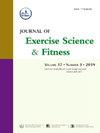Knee strength balance ratios are not affected by aging among male runners
IF 2.4
2区 医学
Q2 SPORT SCIENCES
引用次数: 0
Abstract
Objectives
This study aimed to assess thigh muscular strength, conventional and functional strength balance ratios, and muscle quality in well-trained male runners aged 20–70 yr.
Methods
Eighty-nine male runners were divided into five age categories: 20–29, 30–39, 40–49, 50–59, and 60–70 yr. Participants underwent an isokinetic strength test for knee flexor and extensor muscles and a body composition analysis via dual-energy X-ray absorptiometry.
Results
No significant difference was observed in concentric peak torque of the knee extensor muscles between the 20–29 and 40–49 age groups. However, the 50–59 age group showed significantly lower strength than the 20–29 age group (p = 0.049), and the 60–70 age group demonstrated significantly lower strength than the 40–49 group (p < 0.001). The conventional and functional balance ratios remain stable across all age groups.
Conclusion
Knee flexor and extensor strength in male runners decreases significantly after the age of 50, while conventional and functional strength balance ratios remain stable.
男性跑步者的膝盖力量平衡比不受年龄的影响。
目的:本研究旨在评估20-70岁训练有素的男性跑步者的大腿肌肉力量、常规和功能力量平衡比率以及肌肉质量。方法:89名男性跑步者被分为5个年龄组:20-29岁、30-39岁、40-49岁、50-59岁和60-70岁。参与者接受了膝关节屈肌和伸肌的等速力量测试,并通过双能x线吸收仪进行了身体成分分析。结果:20-29岁和40-49岁年龄组的膝关节伸肌同心峰值扭矩无显著差异。然而,50-59岁年龄组的力量明显低于20-29岁年龄组(p = 0.049), 60-70岁年龄组的力量明显低于40-49岁年龄组(p结论:男性跑步者的膝关节屈伸肌力量在50岁后明显下降,而常规和功能力量平衡比保持稳定。
本文章由计算机程序翻译,如有差异,请以英文原文为准。
求助全文
约1分钟内获得全文
求助全文
来源期刊
CiteScore
5.10
自引率
3.60%
发文量
54
审稿时长
31 days
期刊介绍:
The Journal of Exercise Science and Fitness is the official peer-reviewed journal of The Society of Chinese Scholars on Exercise Physiology and Fitness (SCSEPF), the Physical Fitness Association of Hong Kong, China (HKPFA), and the Hong Kong Association of Sports Medicine and Sports Science (HKASMSS). It is published twice a year, in June and December, by Elsevier.
The Journal accepts original investigations, comprehensive reviews, case studies and short communications on current topics in exercise science, physical fitness and physical education.

 求助内容:
求助内容: 应助结果提醒方式:
应助结果提醒方式:


